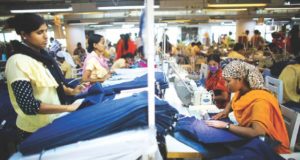Published in The Daily Star on Sunday, 19 June 2016
CPD researcher talks about the challenges in implementing living wage in Bangladesh
Khondaker Golam Moazzem, additional research director of the Centre for Policy Dialogue, attended the Asian Living Wage Conference in Islamabad on May 25-26. The Daily Star caught up with him to know about the idea of living wage. It is a wage that is high enough to maintain a normal standard of living. Moazzem also talked about the current status, potential and challenges for implementing the concept in Bangladesh.
The Daily Star (TDS): How is the idea of living wage taking shape?
 Khondaker Golam Moazzem: After the collapse of the Rana Plaza factory building, development partners, buyers and retailers expressed their concern about the various governance problems of supply chain of the garment sector across the world. A number of steps were also taken at the buyers’ level. Those initiatives were reflected in the Sustainable Compact, which was signed between the International Labour Organisation, the European Union and the Bangladesh government, the plan of action of the United States Trade Representative and the national initiative.
Khondaker Golam Moazzem: After the collapse of the Rana Plaza factory building, development partners, buyers and retailers expressed their concern about the various governance problems of supply chain of the garment sector across the world. A number of steps were also taken at the buyers’ level. Those initiatives were reflected in the Sustainable Compact, which was signed between the International Labour Organisation, the European Union and the Bangladesh government, the plan of action of the United States Trade Representative and the national initiative.
Initiatives have also been taken at the global level. One of the major initiatives centres around the wage of the workers, as the minimum wage now being given to the workers is not sufficient for them and the workers are not getting the market-based rate they should have got. The ILO has worked on providing giving a wage to the workers that is close to living wage. There have been initiatives in the private sector on how much the living wage would be. But these ideas have not taken a firm shape.
Besides civil society and rights organisations that are raising the demand for a living wage, the ILO and development partners are taking part in the debate. Under the initiative, the first Living Wage Conference took place in Berlin in 2013. It was decided then that the living wage issue would be discussed at the regional level on a regular basis. As part of the effort the Asian Living Wage Conference took place in Pakistan.
TDS: Who are mainly working to promote the living wage idea?
Moazzem: The Netherlands and Germany are strongly involved in the process and are playing the key role. The Department for International Development of the UK and Sweden are also involved.
TDS: Tell us about the Asian Living Wage Conference.
Moazzem: Government and non-government representatives, entrepreneurs and trade union leaders of the main apparel producing countries in Asia took part in the conference. Representatives of buyers from other countries and the ILO, and delegates from India, Bangladesh, the Philippines, Vietnam, Cambodia, Myanmar, China, Indonesia and Pakistan also participated in the programme.
TDS: Is the initiative only for the garment sector?
Moazzem: It was being thought that the initiative should start in an area that could provide a strong basis for moving forward. So far, the initiative is centred on the garment industry. The initiative is being thought for developing countries that produce garments and are actively involved in the supply chain.
TDS: What is the aim of the living wage initiative?
Moazzem: The aim of the initiative is to transform the workers’ minimum wage into a living wage, and identify the role of all involved parties in order to make that happen. It also aims to specify the role of brands, retailers, trade unions, local suppliers, development partners and local governments which can play a major role in establishing living wage.
The methodology of the initiative, the possible impact of the initiative, the data to be used, and the role for all parties have not been identified yet clearly. But some kind of consensus is gradually being reached that living wage itself is important. From the experience of participating in the Berlin conference and the minimum wage discussion in Bangladesh I can say that there was some kind of opposition to living wage on the part of the manufacturers. They used to strongly criticise the issue. Now they are soft about it.
TDS: How should the living wage be fixed for Bangladesh?
Moazzem: Different quarters have calculated living wage in different ways. Some are labelling it as the Asian floor wage. The floor wage is fixed on the needs of a family. They have made recommendations for all Asian countries including Bangladesh.
In Bangladesh, workers’ organisations and rights-based organisations are talking about living wage, and can feel its importance. The government’s initiative is limited to the minimum wage board which does not reflect the living wage.
In 2013, the CPD gave its suggestions to the government on the minimum wage. We calculated the minimum wage following the definition of the ILO, and the methodology of its Senior Economist Prof Richard Anker.
According to Prof Anker, the living wage should be fixed on the basis of a family’s needs. If a family has more than one working person it has to be taken into consideration. The family has to save some money from its income.
Using the method, the CPD fixed the living wage, taking into consideration the number of people in a family and the number of working people in a family. In reaching the needs of a family we used three methods: poverty level, actual expenditure level and aspiration level. If the poverty level is taken into consideration, the living wage should be Tk 5,200 in 2013. It was Tk 8,200 at the household expenditure level, and Tk 14,000 if the family’s needed nutrition and calorie and other needs are taken into consideration. The concept is family-based.
TDS: What is the living wage in other countries?
Moazzem: The wage is much higher in other countries. However, living wage varies from one country to another.
TDS: Tell us something about the journey from minimum wage to living wage.
Moazzem: It seems logical that if the living wage increases to a much higher level from Tk 5,300 in a single jump, it might be a problem. In 2013 we also said it can be done step by step. We proposed that the minimum wage could be Tk 6,500 and can be increased later gradually. We have to keep in mind the industry’s ability to pay. If the minimum wage is raised every year, the gap between the minimum wage and the living wage will come down.
Besides, the minimum wage in different sectors is faulty. The wage board sets the minimum wage. But it is seen that the minimum wage happens to be the lower rate of the wage scale, which should not be. As a result, the wage is lower compared to what it should have been.
TDS: What are the challenges in implementing the living wage?
Moazzem: First, it is not clear what definition will be used in Bangladesh. Secondly, under which law it will be implemented. The existing law only talks about the minimum wage and there is nothing about living wage. Third, if the living wage is implemented, who will take the responsibility and how? Will entrepreneurs or buyers take the responsibility? If the buyers don’t want to take the responsibility how will it be implemented? Will it be sector-based or a uniform national living wage? The workers’ representatives have already started to talk about a national living wage.
But I think the initiative should be implemented sector-wise, instead of making it nationally uniform. It will be tough to implement it in one go. The effort should be aimed at narrowing gap between the minimum wage and the living wage. A different legal framework is not needed for a living wage. The initiative should be minimum wage towards a living wage. Then, we will be able to take the initiative forward within the existing framework.
From the Asian Living Wage Conference we have come to understand that the initiative should be rolled out with the help of willing buyers, manufacturers and workers’ bodies, and it will be spread among others later. It has to be taken forward in a self-motivated way. At the conference, buyers showed positive response to living wage.
The living wage has to be a result of a tripartite negotiation process, rather than fixing the rate from outside. If it is imposed it can create imbalance. At the Asian Living Wage Conference it was emphasised that the role of trade unions has to be strengthened and they have to be active during the negotiations on minimum wage so the minimum wage actually transforms into a living wage in the end.
 CPD RMG Study Stitching a better future for Bangladesh
CPD RMG Study Stitching a better future for Bangladesh



